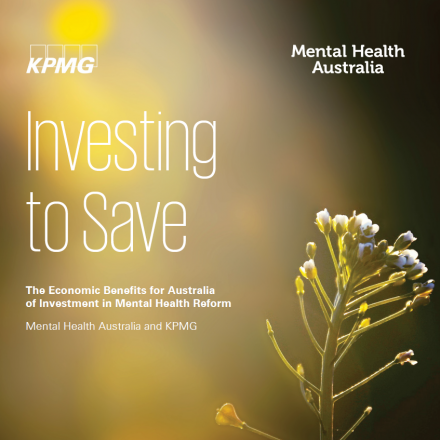National Review of Mental Health Programmes and Services – Preliminary Analysis
Mental Health Australia has undertaken a short analysis of the National Mental Health Commission’s Review following the release of the Commission’s Final Report. A more detailed analysis will be released in the near future.
The entire Final Report can be accessed here. A summary, including the recommendations, is also available here.
Structure: The Report is divided into 4 volumes:
- Volume 1: Strategic Directions Practical Solutions 1-2 years
- Volume 2: Every service is a gateway: Response to Terms of Reference
- Volume 3: What people told us Analysis of formal submissions to the Review
- Volume 4: Supporting Papers Background research and collation of evidence
The Government’s initial response focuses on a consultative and collaborative approach in developing a full response to the Review. Mental Health Australia has welcomed this response, given the complexity of the issues covered in the Final Report.
Key findings and implications
The Review’s 25 recommendations, structured according to nine strategic directions, are reproduced below.
The Review identifies ‘fundamental structural shortcomings’ across ‘a poorly planned and badly integrated system,’ with submissions conveying ‘a hit-and-miss arrangement of services and programmes around the country, seemingly based on no discernible strategy, creating duplication in some areas and considerable unmet need in others.’ The overall impact ‘is a massive drain on people’s wellbeing and participation in the community.’ This is consistent with the findings of many past reviews and inquiries into mental health.
Through its Terms of Reference, the Review considered ‘the efficacy and cost-effectiveness of programmes, services and treatments’, ‘duplication in current services and programs’ and ‘funding priorities in mental health and gaps in services and programmes, in the context of the current fiscal circumstances facing Governments.’ In response, the Review ‘found no real evidence that specific Commonwealth-funded services of programmes were not adding value or that they should be defunded due to lack of impact.’ However, the Commission’s ability to make such judgements was constrained by the limited information available at a state/territory level and on the demonstrated outcomes of funded services.
Reflecting on the current fiscal situation, the Review finds that ‘the strongest expenditure growth is in programmes that can be indicators of system failure… rather than in areas which prevent illness and will reap the biggest returns economically.’ To support its arguments for ‘upstream’ investments to avoid ‘downstream’ costs, the Commission has published modelling by KPMG (here) quantifying the economic gains associated with prevention and early intervention in a range of hypothetical scenarios.
A central finding of the Review is the recommendation to rename Primary Health Networks as ‘Primary and Mental Health Networks’ and use them as the ‘key regional architecture for… planning and purchasing of mental health programmes,’ with funding to be pooled and redistributed to PMHNs on a population-risk basis. The transition from Medicare Locals to Primary Health Networks is still underway, with details on the future operations of PHNs yet to be finalised.
The Review’s proposal to shift $1 billion out of hospitals is recommended as a staged transition, starting at $50 million in 2017-18 and increasing to $300 million per annum in 2021-22. The Commission intends for this funding to be re-invested in community-based supports, and expects hospital demand to shrink in response over time.
The focus of the Review is on action that can be taken through the health and mental health systems. Less consideration is given to changes required in the employment, housing, justice or education systems to meet the needs of mental health consumers and carers. Similarly, there is little detail on how the current mental health system(s) might be integrated with the National Disability Insurance Scheme over time.
Although the Final Report makes no mention of Mental Health Australia or its Blueprint for Action on Mental Health, many of the Review’s findings are consistent with the Blueprint’s recommendations. For example:
The Commission laments the lack of consistent national outcome measures and proposes that governments collectively set targets for long-term reform.
The Review emphasises the importance of better coordination between governments, arguing that ‘the roles and responsibilities of the Commonwealth on the one hand, and the states and territories on the other, should be agreed and documented through a new Intergovernmental Agreement.’
In other areas there is some divergence between the Review’s findings and Mental Health Australia’s position. For instance, the Review makes no recommendations in relation to formal mechanisms for consumer and carer representation and leadership. Further comparison of the Review’s Final Report with Mental Health Australia’s Blueprint will be published in the near future.
__________
National Review of Mental Health Programmes and Services - Recommendations
Strategic Direction 1: Set clear roles and accountabilities to shape a person-centred mental health system
Recommendations
1. Agree the Commonwealth’s role in mental health is through national leadership and regional integration, including integrated primary and mental health care.
2. Develop, agree and implement a National Mental Health and Suicide Prevention Plan with states and territories, in collaboration with people with lived experience, their families and support people.
3. Urgently clarify the eligibility criteria for access to the National Disability Insurance Scheme (NDIS) for people with disability arising from mental illness and ensure the provision of current funding into the NDIS allows for a significant Tier 2 system of community supports.
Strategic Direction 2: Agree and implement national targets and local organisational performance measures
Recommendations
4. Adopt a small number of important, ambitious and achievable national targets to guide policy decisions and directions in mental health and suicide prevention.
5. Make Aboriginal and Torres Strait Islander mental health a national priority and agree an additional COAG Closing the Gap target specifically for mental health.
6. Tie receipt of ongoing Commonwealth funding for government, NGO and privately provided services to demonstrated performance, and use of a single care plan and eHealth record for those with complex needs.
Strategic Direction 3: Shift funding priorities from hospitals and income support to community and primary health care services
Recommendations
7. Reallocate a minimum of $1 billion in Commonwealth acute hospital funding in the forward estimates over the five years from 2017–18 into more community-based psychosocial, primary and community mental health services.
8. Extend the scope of Primary Health Networks (renamed Primary and Mental Health Networks) as the key regional architecture for equitable planning and purchasing of mental health programmes, services and integrated care pathways.
9. Bundle-up programmes and boost the role and capacity of NGOs and other service providers to provide more comprehensive, integrated and higher-level mental health services and support for people, their families and supporters.
10. Improve service equity for rural and remote communities through place-based models of care.
Strategic Direction 4: Empower and support self-care and implement a new model of stepped care across Australia
Recommendations
11. Promote easy access to self-help options to help people, their families and communities to support themselves and each other, and improve ease of navigation for stepping through the mental health system.
12. Strengthen the central role of GPs in mental health care through incentives for use of evidence-based practice guidelines, changes to the Medicare Benefits Schedule and staged implementation of Medical Homes for Mental Health.
13. Enhance access to the Better Access programme for those who need it most through changed eligibility and payment arrangements and a more equitable geographical distribution of psychological services.
14. Introduce incentives to include pharmacists as key members of the mental health care team.
Strategic Direction 5: Promote the wellbeing and mental health of the Australian community, beginning with a healthy start to life
Recommendations
15. Build resilience and targeted interventions for families with children, both collectively and with those with emerging behavioural issues, distress and mental health difficulties.
16. Identify, develop and implement a national framework to support families and communities in the prevention of trauma from maltreatment during infancy and early childhood, and to support those impacted by childhood trauma.
17. Use evidence, evaluation and incentives to reduce stigma, build capacity and respond to the diversity of needs of different population groups.
Strategic Direction 6: Expand dedicated mental health and social and emotional wellbeing teams for Aboriginal and Torres Strait Islander people
Recommendations
18. Establish mental health and social and emotional wellbeing teams in Indigenous Primary Health Care Organisations (including Aboriginal Community Controlled Health Services), linked to Aboriginal and Torres Strait Islander specialist mental health services.
Strategic Direction 7: Reduce suicides and suicide attempts by 50 per cent over the next decade
Recommendation
19. Establish 12 regions across Australia as the first wave for nationwide introduction of sustainable, comprehensive, whole-of-community approaches to suicide prevention.
Strategic Direction 8: Build workforce and research capacity to support systems change
Recommendations
20. Improve research capacity and impact by doubling the share of existing and future allocations of research funding for mental health over the next five years, with a priority on supporting strategic research that responds to policy directions and community needs.
21. Improve supply, productivity and access for mental health nurses and the mental health peer workforce.
22. Improve education and training of the mental health and associated workforce to deploy evidence-based treatment.
23. Require evidence-based approaches on mental health and wellbeing to be adopted in early childhood worker and teacher training and continuing professional development.
Strategic Direction 9: Improve access to services and support through innovative technologies
Recommendations
24. Improve emergency access to the right telephone and internet-based forms of crisis support, and link crisis support services to ongoing online and offline forms of information/education, monitoring and clinical intervention.
25. Implement cost-effective second and third generation e-mental health solutions that build sustained self-help, link to biometric monitoring and provide direct clinical support strategies or enhance the effectiveness of local services.
| Attachment | Kind | Size |
|---|---|---|
| 1.05 MB |




